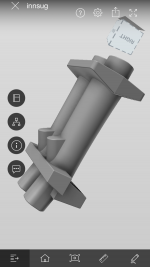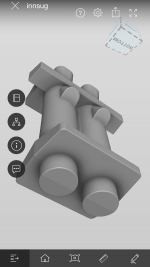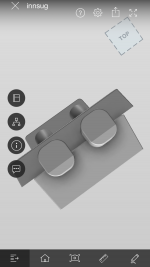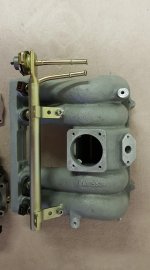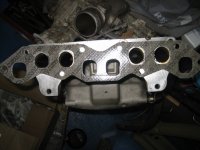
You are using an out of date browser. It may not display this or other websites correctly.
You should upgrade or use an alternative browser.
You should upgrade or use an alternative browser.
EFI/Individual throttle bodies on old renaults
- Thread starter ReidarUF
- Start date
Not being satisfied with my design I started building a more elegant pattern. While splitting a wooden round stock the saw took most of the tip of my left index finger.
A nurse guarding his bleeding and aching finger with his life is no good so I had a month sick leave.
Anyway I spent this time learning Fusion 360. Drawing the same few things over and over I’m now getting the hand of it. A few more details and I’m ready to print my new pattern.
A nurse guarding his bleeding and aching finger with his life is no good so I had a month sick leave.
Anyway I spent this time learning Fusion 360. Drawing the same few things over and over I’m now getting the hand of it. A few more details and I’m ready to print my new pattern.
Attachments
Hi Reidar, Never use a rip saw to split a round piece of wood. Lesson learned. Where's a pic of the wood shavings?Not being satisfied with my design I started building a more elegant pattern. While splitting a wooden round stock the saw took most of the tip of my left index finger.
A nurse guarding his bleeding and aching finger with his life is no good so I had a month sick leave.
Anyway I spent this time learning Fusion 360. Drawing the same few things over and over I’m now getting the hand of it. A few more details and I’m ready to print my new pattern.
Unless you can 3D print in moulding sand, I would say he's going to print the cores used to make the moulds but am not sure the 3D finish would be that good.
Yeah, watch your fingers around machines. I didn't lose my index finger but lost all feeling in it when it got caught in the milling cutter.
Yeah, watch your fingers around machines. I didn't lose my index finger but lost all feeling in it when it got caught in the milling cutter.
100 m - wow. Have you measured the voltage that the kiln actually receives when it is running???Oldfoundryman is my favourite. I,ve spent quite a few hours watching his videos. And there is lots of little details to pick up. I plan to stay clear of both fluxes and degassers etc for now. Keep it simple. This time I got closer to getting the gating right(copying olfoundryman) while the temperatures were all over the place. I use a electric kiln that is dead slow and a 100m cord does not help.
I have not done that yet. The cable is 2,5mm2 but the kiln takes at least 30min to get to temperature so there is a considerate voltage drop. My mig welder works fine though.100 m - wow. Have you measured the voltage that the kiln actually receives when it is running???
At least two things yes. Thats life..Yeah ouch Reidar! :S
But hay you learnt at least 2 x new things!
You intend to get the moulds 3D printed and cast from them?
I intend to print the pattern and do some green sand casting. I’m no expert at that neither but did get usable results from the wooden pattern. The biggest difference is the core box. Then it was a split pipe. Now its 3d printed with around a designed inlet path.
I bought a second hand Flashforge Finder 3D printer. It can only print 140x140x140mm so the pattern will have to be printed in parts and glued together. Not a major problem. It was cheap, prints nice and they are known to be bullet proof.
One of the guys at the English turborenault forum were looking for an EFI inlet manifold for his R5gtt and found the manifold from Skoda Felicia 1,3 to have the same port pattern. It left to little rom for the exhaust however so it was put to side.
Its actually quite nice. If I were not aiming for ITB I would considder it.
But for now I’m more into its fuel rail. A friend in Czech Republic were kind to get me a brand new one but postage are super slow theese days.
Its actually quite nice. If I were not aiming for ITB I would considder it.
But for now I’m more into its fuel rail. A friend in Czech Republic were kind to get me a brand new one but postage are super slow theese days.
Attachments
Last edited:
"Oldfoundryman is my favourite. I,ve spent quite a few hours watching his videos. And there is lots of little details to pick up. I plan to stay clear of both fluxes and degassers etc for now. Keep it simple. This time I got closer to getting the gating right(copying olfoundryman) while the temperatures were all over the place. I use a electric kiln that is dead slow and a 100m cord does not help."
"100 m - wow. Have you measured the voltage that the kiln actually receives when it is running???"
"I have not done that yet. The cable is 2,5mm2 but the kiln takes at least 30min to get to temperature so there is a considerate voltage drop.My mig welder works fine though."
What is current draw or the Kw rating of your kiln Reidar? I assume your voltage supply there is 220 volts.
"100 m - wow. Have you measured the voltage that the kiln actually receives when it is running???"
"I have not done that yet. The cable is 2,5mm2 but the kiln takes at least 30min to get to temperature so there is a considerate voltage drop.My mig welder works fine though."
What is current draw or the Kw rating of your kiln Reidar? I assume your voltage supply there is 220 volts.
Hi COL. The kiln is 1900W/220V. Is it within limits or far out?What is current draw or the Kw rating of your kiln Reidar? I assume your voltage supply there is 220 volts.
Surprise its within limits which is 5% here in Australia.Hi COL. The kiln is 1900W/220V. Is it within limits or far out?
Your voltage drop is 2.749%.
Heating up kilns are a slow process and so is controlling the temperature inside them. What sort of temperature control are you using?
Regarding voltage drop, you would need a cable to have less than 12.73 mV/Am ( milli volts per Ampere Metre) to be within the Australian standard of a maximum 5% voltage drop using your voltage and current draw and length of run. A 4 sqmm flexible lead is just outside this at 13 mV/Am.
By comparison, and certainly there is some overkill in the 30 metre 3 phase run to my shed in 10 sq mm. Yes, I am an electrician.
Seems we have some differing maths. I have the circuit using a 2.5mm lead (18mV/Am) 100m long having a 15.53v drop at 8.64A (1900W divided by the 220V supplied) load so coming in at just over a 7% voltage drop currently. Happy to be proved wrong. Can’t say I do the calculations for this very often, but believe I am correct.
By comparison, and certainly there is some overkill in the 30 metre 3 phase run to my shed in 10 sq mm. Yes, I am an electrician.
Seems we have some differing maths. I have the circuit using a 2.5mm lead (18mV/Am) 100m long having a 15.53v drop at 8.64A (1900W divided by the 220V supplied) load so coming in at just over a 7% voltage drop currently. Happy to be proved wrong. Can’t say I do the calculations for this very often, but believe I am correct.
Last edited:
So I might be within or far out.
I’m planning to build an oil fired furnace. but until then my slightly underpowered kiln will do.
I’m planning to build an oil fired furnace. but until then my slightly underpowered kiln will do.
Well, Alan's calculations would suggest you're far out if by that you mean your kiln doesn't actually give you the 1.9KW on the tin so to speak. I would say your drop is more than that and wouldn't be surprised to see under 200V at the kiln. A multimeter would tell you where you really are.
how would it effect your voltage drop calk if cable was berried in snow ,Norway
I used an online calculator as I couldn't be bothered to go and look up what we use here so maybe the calculator that i used was not correct.Regarding voltage drop, you would need a cable to have less than 12.73 mV/Am ( milli volts per Ampere Metre) to be within the Australian standard of a maximum 5% voltage drop using your voltage and current draw and length of run. A 4 sqmm flexible lead is just outside this at 13 mV/Am.
By comparison, and certainly there is some overkill in the 30 metre 3 phase run to my shed in 10 sq mm. Yes, I am an electrician.
Seems we have some differing maths. I have the circuit using a 2.5mm lead (18mV/Am) 100m long having a 15.53v drop at 8.64A (1900W divided by the 220V supplied) load so coming in at just over a 7% voltage drop currently. Happy to be proved wrong. Can’t say I do the calculations for this very often, but believe I am correct.
I have found a better online calculator and fed the numbers into it.
https://elek.com.au/resources/calculators/cable-size-as3008/
It has come back with the recommended cable size of 4mm²
Voltage drop on 2.5mm² cable is 6.08%
Voltage drop on 4mm² cable is 3.81%
so replacing your cable 2.5 with a 4mm² you will gain an extra 5 volts at the kiln.
Like i said in post #72 I was surprised that it worked out within the 5%, just shows you can't trust every site you come across.
https://elek.com.au/resources/calculators/cable-size-as3008/
It has come back with the recommended cable size of 4mm²
Voltage drop on 2.5mm² cable is 6.08%
Voltage drop on 4mm² cable is 3.81%
so replacing your cable 2.5 with a 4mm² you will gain an extra 5 volts at the kiln.
Like i said in post #72 I was surprised that it worked out within the 5%, just shows you can't trust every site you come across.
Last edited:
When I did the calculations using AS3008.1.1 I got the same as you AlanRegarding voltage drop, you would need a cable to have less than 12.73 mV/Am ( milli volts per Ampere Metre) to be within the Australian standard of a maximum 5% voltage drop using your voltage and current draw and length of run. A 4 sqmm flexible lead is just outside this at 13 mV/Am.
By comparison, and certainly there is some overkill in the 30 metre 3 phase run to my shed in 10 sq mm. Yes, I am an electrician.
Seems we have some differing maths. I have the circuit using a 2.5mm lead (18mV/Am) 100m long having a 15.53v drop at 8.64A (1900W divided by the 220V supplied) load so coming in at just over a 7% voltage drop currently. Happy to be proved wrong. Can’t say I do the calculations for this very often, but believe I am correct.
That is a good question but a highly hypoteticly one as there have been about 4-5days of snow the last couple of years. I hope that is a coincidence.how would it effect your voltage drop calk if cable was berried in snow ,Norway
As far as I remember resistance increases with heat so I guess snow would help a bit.
Last edited:
